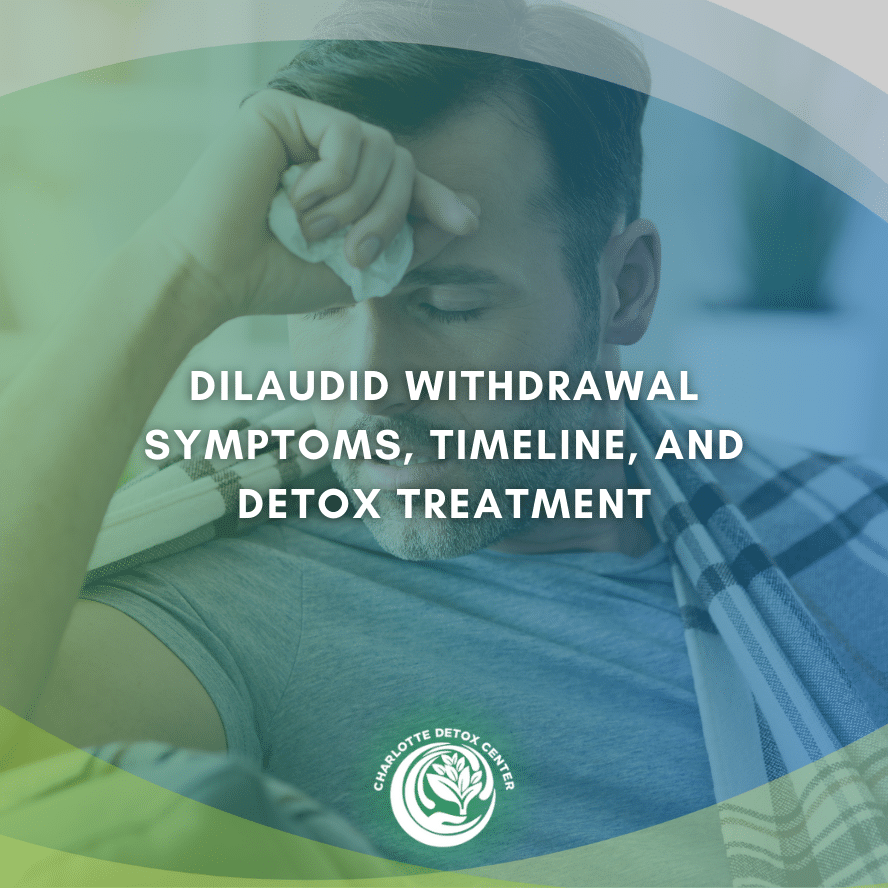Dilaudid Withdrawal Symptoms, Timeline, and Detox Treatment

Medically Verified: 2/1/24
Medical Reviewer
Chief Editor

All of the information on this page has been reviewed and verified by a certified addiction professional.
Opioid use disorder is incredibly common in the United States. Unfortunately, opioid addiction is equally as dangerous as it is common. According to the National Institute of Drug Abuse (NIDA), there were 80,411 opioid overdose deaths in 2021.[1]
Dilaudid is the brand name for an opioid medication called hydromorphone. Hydromorphone is prescribed to treat pain in patients who are tolerant of other opioid substances.[2] The drug is known to be highly addictive because of its habit-forming properties.
If you or a loved one abuse Dilaudid, you may become physically dependent on it, meaning that if you suddenly stop taking it, you will experience symptoms of withdrawal. Dilaudid withdrawal symptoms and the timeline can vary from one person to the next based on the length of opioid abuse and other individual factors.
What are the Symptoms of Dilaudid Withdrawal?
When you are addicted to Dilaudid, your brain grows accustomed to the presence of it in your system, but if it is suddenly removed, your body will go into withdrawal. Dilaudid is an opioid that slows down breathing, respiration, and other central nervous system functions. While under the influence, your body has to work harder to sustain breathing and other functions, and it adapts to acting in this overactive state to compensate for the drug’s depressant effects.
When you stop taking Dilaudid or another opioid, your body will continue performing in this excited state. But without an opioid, this excited state results in excess neurotransmitters that cause agitation, sweating, and flu-like symptoms of withdrawal.
Symptoms of Dilaudid (hydromorphone) withdrawal may include:[3]
- Nausea and vomiting
- Restlessness or irritability
- Anxiety
- Fever and sweating
- Diarrhea
- Chills
- Body aches
- Muscle spasms and pain
- Depression and suicidal thoughts
- Confusion
- Cravings to use Dilaudid
While the symptoms of hydromorphone withdrawal are usually not life-threatening, it can be extremely dangerous to detox without professional help. For starters, symptoms of vomiting and diarrhea can cause you to become seriously dehydrated. Even further, symptoms like depression can cause you to become suicidal.
Lastly, if you attempt to detox at home you are at risk of relapsing, and if you attempt to abuse the same dose of Dilaudid as you did when you had a tolerance, you could experience a life-threatening overdose. As a result, you should always attend a drug detox program.
The Dilaudid Withdrawal Timeline
The exact Dilaudid withdrawal timeline will vary from person to person. Factors like overall health, body weight, the dose you were taking, and how long you were abusing the substance can play a role in how long you experience symptoms.
However, most people follow a general timeline when it comes to Dilaudid withdrawal. This timeline is as follows:
4 to 8 Hours
Within 4 to 8 hours after your last dose, you might experience the initial symptoms of withdrawal. Initial symptoms may include mild nausea, restlessness, irritability, anxiety, fever, sweating, and cravings for Dilaudid.
12 to 48 Hours
Most individuals experience peak withdrawal symptoms sometime between 12 to 48 hours after their last dose. If you were a heavy user, you might experience worse symptoms faster than someone with a mild addiction.
These symptoms can include:
- Nausea and vomiting
- Diarrhea
- Excessive sweating
- Fever
- Chills
- Headaches
- Muscle spasms and pains
- Insomnia
- Anxiety and depression
- Uncontrollable urges to abuse Dilaudid
48 to 72 Hours
Sometime between 48 to 72 hours after your last dose of Dilaudid, your symptoms will begin to lessen in severity. However, it is still common to experience slight nausea, anxiety, irritability, depression, and cravings.
5 to 7 Days
More often than not, Dilaudid withdrawal resolves after 5 to 7 days. Some individuals may develop post-acute withdrawal syndrome (PAWS), which causes them to experience psychological symptoms of withdrawal for much longer.[4] These symptoms can last for months on end, requiring extra treatment.
How is Dilaudid Withdrawal Treated During Detox?
When you arrive at a detox center, you will undergo an initial assessment to determine your needs. The medical staff will ask you questions about your substance abuse, mental health, physical health, and family history. All of this information will be used to create an individualized treatment plan.
After your treatment plan is created, you will be checked to ensure that you are in good health. This involves checking your vitals and treating any issues that may arise. Additionally, you will be given medication to limit your withdrawal symptoms and prevent cravings to make the withdrawal process safe, comfortable, and easier to cope with.
Typically, medications like Suboxone or methadone are used to treat Dilaudid withdrawal. These substances target the opioid receptors in your brain to trick it into thinking it’s received the substances it’s dependent on without getting you high. Over time, your doctors will lessen your dose until you do not require the medication anymore.
Find Help for Dilaudid Abuse and Addiction
If you or a loved one suffer from hydromorphone addiction, it’s time to seek professional help. At Charlotte Detox Center, we can provide you with the medication and support required to keep you comfortable and safe throughout the withdrawal portion of your recovery.
To learn more about our opioid detox programs, contact us today.
References:
- The National Institute of Drug Abuse (NIDA): Drug Overdose Death Rates, Retrieved June 2023 From https://nida.nih.gov/research-topics/trends-statistics/overdose-death-rates
- Medline Plus: Hydromorphone, Retrieved June 2023 From https://medlineplus.gov/druginfo/meds/a682013.html
- Medline Plus: Opiate and Opioid Withdrawal, Retrieved June 2023 From https://medlineplus.gov/ency/article/000949.htm
- Semel Institute for Neuroscience and Human Behavior: Post-Acute Withdrawal Syndrome, Retrieved June 2023 From https://www.semel.ucla.edu/dual-diagnosis-program/News_and_Resources/PAWS
